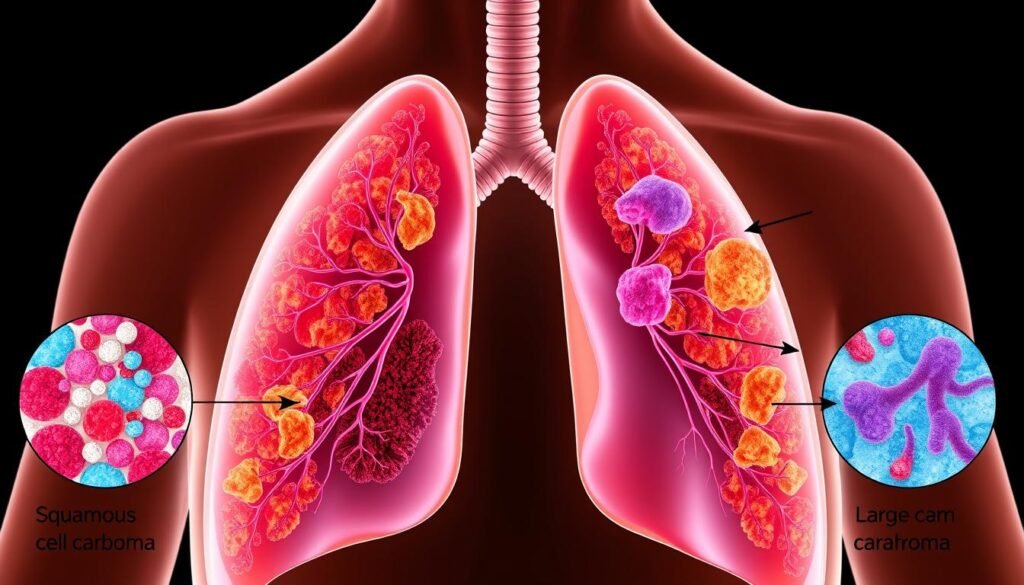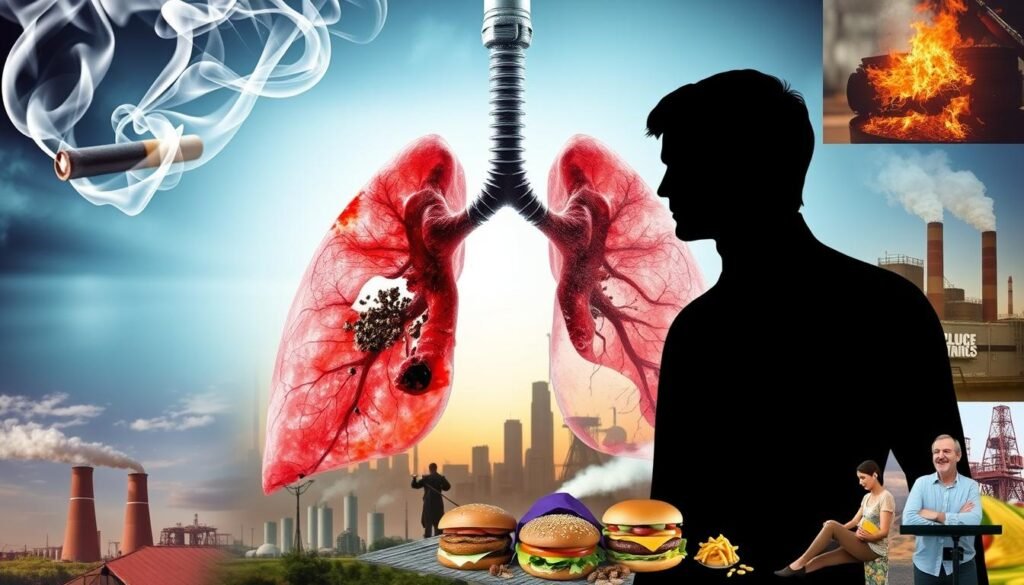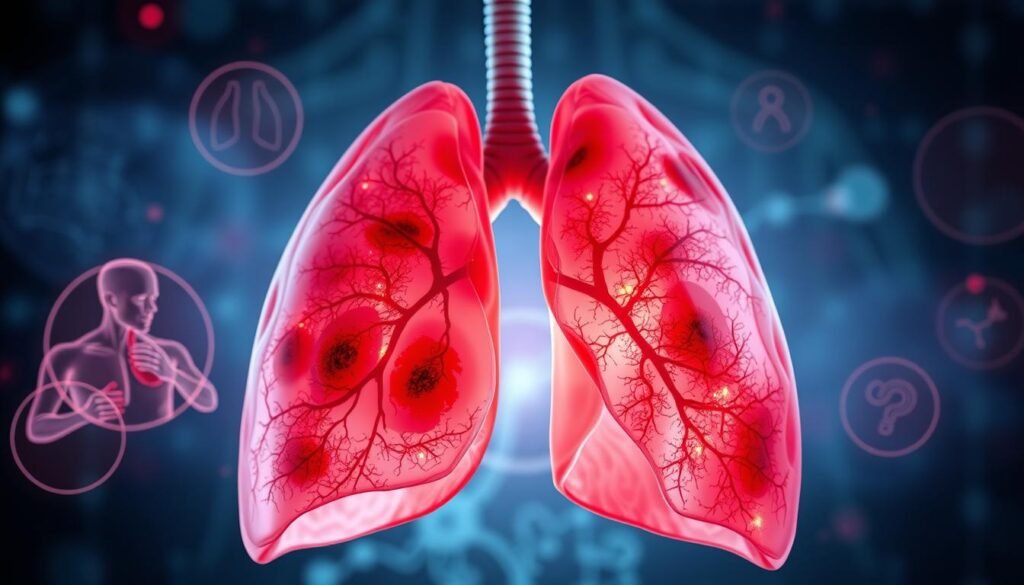Did you know about 80% to 85% of lung cancers are called non-small cell lung cancer (NSCLC)? Squamous cell carcinoma makes up around 30% of these NSCLC cases. It’s quite common within lung cancer types. This article aims to dive deep into lung squamous cell carcinoma. We’ll explore its characteristics, risk factors, symptoms, and how it’s diagnosed. This information is key for patients, caregivers, and healthcare providers. Having knowledge is crucial when dealing with cancer treatment and support. This guide is a valuable tool for anyone affected by this illness.
Key Takeaways
- Lung squamous cell carcinoma constitutes about 30% of non-small cell lung cancer cases.
- Non-small cell lung cancer accounts for roughly 80% of all lung cancer cases.
- This subtype is primarily linked to a history of smoking.
- The disease often presents symptoms such as cough, chest pain, and shortness of breath.
- Diagnostic imaging like CT scans plays a crucial role in identifying squamous cell lung tumors.
- Effective treatment may include surgery, chemotherapy, and other modalities tailored to the cancer stage.
What is Squamous Cell Lung Cancer?
Squamous cell lung cancer is a type of lung cancer coming from squamous cells. These cells are found in the airways. It makes up about 30% of all lung cancers. Smoking is a big risk for this kind of lung cancer.
People with this cancer might cough, have trouble breathing, feel chest pain, or see blood when they cough. It often starts in the middle of the lung or in the big airways. This causes the symptoms and can make lung function worse over time.
This cancer can spread to the brain, bones, liver, adrenal glands, and the spine. Catching and treating it early is very important because of how it can spread.
Treatment can include surgery, radiation, chemotherapy, and immunotherapy. Doctors make a plan based on what the patient needs. They also test for a protein called PD-L1. This helps decide if treatments like pembrolizumab (Keytruda®) will work well.
| Cancer Characteristics | Details |
|---|---|
| Prevalence | Approximately 30% of all lung cancers |
| Common Location | Central part of the lung or main airways |
| Associated Risk Factor | Smoking tobacco primarily |
| Common Symptoms | Cough, trouble breathing, chest pain, blood in sputum |
| Potential for Metastasis | Brain, spine, bones, adrenal glands, liver |
| Recommended Testing | Comprehensive biomarker testing according to NCCN guidelines |
Overview of NSCLC and How It Differs from Small Cell Lung Cancer
Non-small cell lung cancer (NSCLC) makes up about 85 percent of all lung cancer cases. It includes several types, like adenocarcinoma, the most common, squamous cell carcinoma, and large cell carcinoma. On the other hand, small cell lung cancer (SCLC) is less common. It represents around 15 percent of cases. SCLC grows quickly and is more aggressive.
Defining Non-Small Cell Lung Cancer (NSCLC)
NSCLC is divided into types depending on tumor cell traits. Adenocarcinoma comes from mucus-producing glandular cells, found mainly on the lungs’ outer parts. Squamous cell carcinoma grows slowly and starts in the flat cells lining the respiratory tract. Large cell carcinoma is rarer and more aggressive. It spreads quicker. Knowing these differences helps us understand how to treat them.
Comparison with Small Cell Lung Cancer (SCLC)
NSCLC and SCLC differ mainly in how fast they grow and spread. SCLC starts in the bronchi and spreads fast, worsening symptoms like chronic cough and chest pain, which are also seen in NSCLC. Treatments vary greatly. SCLC usually needs chemotherapy, whereas NSCLC might need surgery, chemotherapy, and other therapies. For detailed info, check this overview of lung cancer types.
| Characteristic | NSCLC | SCLC |
|---|---|---|
| Percentage of Cases | 85% | 15% |
| Growth Rate | Slower | Faster |
| Common Symptoms | Chronic cough, chest pain, weight loss | Bone pain, confusion, seizures |
| Treatment Options | Surgery, chemotherapy, targeted therapy | Chemotherapy, radiation |
Types of Lung Cancer
Lung cancer comes in mainly two types: small cell (SCLC) and non-small cell (NSCLC). NSCLC has subtypes that differ in treatment and results. Knowing these differences helps doctors treat patients better.
Common Types of Non-Small Cell Lung Cancer
Most lung cancers—over 80%—are non-small cell. This group includes:
- Adenocarcinoma: The most common, making up about 40% of NSCLC cases. It’s seen in smokers and non-smokers.
- Squamous Cell Carcinoma: This makes up about one-third of NSCLC cases. It’s linked to smoking and starts in the central airways.
- Large Cell Carcinoma: Found in about 10% of NSCLC cases, it grows fast and spreads quickly.
Each NSCLC type has unique growth patterns and symptoms. For more information on lung cancer types, check out this article.
Specific Characteristics of Squamous Cell Carcinoma
Squamous cell carcinoma starts in the central airways. It can cause coughing, blood in sputum, and breathing problems. These symptoms are more common because of its location.
Understanding its traits helps doctors choose the best treatment. Genetics also play a role in this cancer type. This gives hope for better diagnosis and treatment methods. More on genetics and cancer can be found here.

Risk Factors for Squamous Cell Lung Cancer
It’s key to know the risks for squamous cell lung cancer to prevent and find it early. This disease is complex, with lifestyle and environment playing big parts.
Role of Smoking and Tobacco Use
Smoking and tobacco are the top risks for this cancer, making up about 80% of the deaths. Most cases are directly linked to cigarette smoking. Additionally, being around smoke from others ups your risk.
E-cigarettes, though seen as tobacco products by the FDA, harm the lungs too.
Family History and Genetic Factors
Having lung cancer in your family can raise your own risk, pointing to genetic links. Scientists found a gene area that ups lung cancer risk in some people. This shows how genes can increase your chances of getting lung cancer.
Environmental Exposures
Being around certain harmful substances can also make you more likely to get this cancer. Radon and asbestos are big ones, with radon being the second main cause of lung cancer in the U.S. according to the US Environmental Protection Agency. Pollution from cars and factories causes 1% to 2% of lung cancer deaths.
Jobs with exposure to cancer-causing chemicals also make lung cancer more likely.

Symptoms of Lung Squamous Cell Carcinoma
Knowing the symptoms of lung squamous cell carcinoma is key for early catch and treatment. People often describe a variety of symptoms with different levels of intensity. It’s important to spot these signs early on. This helps tell squamous cell carcinoma apart from other lung cancers.
Common Symptoms Experienced by Patients
Those with squamous cell lung cancer usually report:
- Persistent cough
- Chest pain
- Shortness of breath (dyspnea)
- Weight loss
- Hemoptysis (blood in sputum)
Other signs can include a hoarse voice and swelling in the neck and face. They might also feel pain and weakness in the shoulder, arm, or hand. Sometimes, patients get recurring lung infections. While these are common symptoms, early-stage cancers might not show any signs at all.
Differences from Other Lung Cancer Symptoms
It’s crucial to know how squamous cell lung cancer symptoms differ from other lung cancers. For example, small cell lung cancer often comes with severe symptoms like bone pain, confusion, and seizures. These are less likely in squamous cell carcinoma cases. Knowing the differences aids doctors in diagnosing and deciding on the right treatment.

| Symptom | Squamous Cell Lung Cancer | Small Cell Lung Cancer |
|---|---|---|
| Persistent Cough | Common | Common |
| Chest Pain | Common | Common |
| Shortness of Breath | Common | Common |
| Weight Loss | Common | Common |
| Hemoptysis | Common | Less Common |
| Bone Pain | Rare | Common |
| Seizures | Rare | Common |
Diagnosing Squamous Cell Lung Cancer
The journey to diagnose squamous cell lung cancer starts by examining the patient’s medical history and a physical check. Doctors usually begin with chest X-rays or CT scans. These tests help spot any oddities that might hint at lung cancer. If they find something unusual, like suspicious nodules, they know they need to look closer.
To confirm squamous cell lung cancer, a biopsy is essential. This means taking a tiny piece of tissue to study under a microscope. The way doctors collect this tissue sample can vary. It depends on where the abnormality is and other personal health factors.
After the biopsy, the results are crucial for figuring out the lung cancer type. Knowing if it’s squamous cell lung cancer affects how doctors plan treatment. This process involves a team effort from several specialists. They work together to make sure the diagnosis is right and the treatment plan works best for the patient.
| Step | Description |
|---|---|
| Initial Evaluation | Patient history and physical examination are conducted to gather information. |
| Imaging Tests | Chest X-rays and CT scans help identify abnormalities in the lungs. |
| Biopsy | A tissue sample is taken for laboratory analysis to confirm squamous cell lung cancer. |
| Results Interpretation | Pathologists analyze biopsy results to determine the cancer type and stage. |
Lung Cancer Staging
Lung cancer staging is key in treating lung squamous cell carcinoma. It checks the cancer’s spread using the TNM system. This approach helps understand the tumor size, if lymph nodes are involved, and any metastasis.
Understanding the TNM Staging System
The TNM system helps doctors put lung cancer into stages, from 0 to IV. Knowing these stages helps pick the best treatment. It includes:
| Stage | Characteristics |
|---|---|
| Stage 0 | Early, localized non-invasive cancer. |
| Stage I | Tumor is small and has not spread to lymph nodes. |
| Stage II | Tumor may have spread to nearby lymph nodes. |
| Stage III | More extensive lymph node involvement. |
| Stage IV | Advanced cancer with distant metastasis. |
Importance of Staging in Treatment Planning
Staging is crucial for planning treatment. It helps design a specific approach based on how far the cancer has spread. For early stages, options might include surgery or targeted treatments.
The stage at diagnosis greatly affects survival rates. For example, early-stage NSCLC could have a 64% survival rate. But advanced stages could drop to about 8%.
Biomarkers and Their Role in Squamous Cell Lung Cancer
Biomarkers are key in figuring out lung squamous cell carcinoma, guiding treatment choices. They pinpoint specific gene mutations, helping doctors predict treatment outcomes. This matters a lot because lung cancer comes in different types. Squamous cell carcinoma makes up about 20-30% of these.
Looking at PD-L1 protein levels helps see if a patient can get immunotherapy. Sadly, less than 20% of lung cancer patients are found early. For those in late stages, biomarkers guide doctors to other treatments, like platinum-based chemotherapy.
Studies on biomarkers are always moving forward, offering new info. Squamous cell carcinoma, for example, has a unique mutation pattern compared to other lung cancers. With squamous cells, EGFR mutations happen about 3% of the time. Also, the PTEN deletion is seen in around 16% of cases.
This deep dive into biomarkers helps doctors create personalized plans. Their goal is to get better treatments out there. And, they aim to lift survival rates for those battling this tough condition.